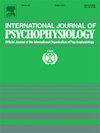经皮电刺激对射击、认知和健康应激反应的影响
IF 2.5
3区 心理学
Q3 NEUROSCIENCES
引用次数: 0
摘要
经皮电刺激三叉神经和颈神经(TEN)被认为是一种安全、无创的减压方法。然而,它对人类表现和应激生理的影响尚未被探索。本研究通过执行功能和注意力的实验室标准测试,以及需要持续区分敌我目标的复杂射击任务,探索了TEN对应激生理反应和认知表现的影响。30名健康的男性和女性参与者完成了两个单盲实验,其中在射击和认知评估之前,使用TEN或sham(顺序平衡,每组n = 15) 20分钟。心率变异性通过心电图和光容积脉搏波连续监测,同时定期收集唾液应激标志物(皮质醇、α-淀粉酶)。采用标准化回归系数(βstan)和95%置信区间(CI)的线性混合模型分析表明,刺激条件(TEN与sham)对射击性能、认知、唾液皮质醇或α-淀粉酶没有影响。然而,观察到刺激条件对心率变异性的显著影响,包括射击时光波脉搏波平均心率增加(βstan = - 0.42 (95% CI -0.69 - -0.14), p = 0.04),极低频功率降低(βstan = 1.51 (95% CI 0.53-2.49), p = 0.04),静止时心电图高频功率增加(βstan = - 0.63 (95% CI -1.06 - -0.21), p = 0.05)。这些结果表明,TEN可能通过对交感和副交感神经系统活动的矛盾作用来调节应激反应。本文章由计算机程序翻译,如有差异,请以英文原文为准。
Influence of transcutaneous electrical stimulation on marksmanship, cognition, and the healthy stress response
Transcutaneous electrical stimulation of the trigeminal and cervical nerves (TEN) has been proposed as a safe, noninvasive method of reducing stress. However, its effects on human performance and stress physiology have yet to be explored. This study explored the effects of TEN on physiological responses to stress and cognitive performance using both laboratory-standard tests of executive function and attention and a complex marksmanship task requiring sustained discrimination of friend or foe targets. Thirty healthy male and female participants completed two, single-blinded experimental sessions in which TEN or sham (order counterbalanced, n = 15 each group) was administered for 20 min prior to marksmanship and cognitive assessment. Heart rate variability was monitored continuously via electrocardiography and photoplethysmography while salivary markers of stress (cortisol, α-amylase) were collected at regular intervals. Linear mixed model analyses with standardized regression coefficients (βstan) and 95 % confidence intervals (CI) indicated no effects of stimulation condition (TEN versus sham) on marksmanship performance, cognition, salivary cortisol, or α-amylase. However, significant effects of stimulation condition were observed on heart rate variability, including increased photoplethysmography mean heart rate (βstan = −0.42 (95 % CI -0.69 - -0.14), p = 0.04) and decreased very low frequency power (βstan = 1.51 (95 % CI 0.53–2.49), p = 0.04) during marksmanship and increased electrocardiography high-frequency power at rest (βstan = −0.63 (95 % CI -1.06 - -0.21), p = 0.05). These results suggest that TEN may modulate the stress response via paradoxical effects on both sympathetic and parasympathetic nervous system activity.
求助全文
通过发布文献求助,成功后即可免费获取论文全文。
去求助
来源期刊
CiteScore
5.40
自引率
10.00%
发文量
177
审稿时长
3-8 weeks
期刊介绍:
The International Journal of Psychophysiology is the official journal of the International Organization of Psychophysiology, and provides a respected forum for the publication of high quality original contributions on all aspects of psychophysiology. The journal is interdisciplinary and aims to integrate the neurosciences and behavioral sciences. Empirical, theoretical, and review articles are encouraged in the following areas:
• Cerebral psychophysiology: including functional brain mapping and neuroimaging with Event-Related Potentials (ERPs), Positron Emission Tomography (PET), Functional Magnetic Resonance Imaging (fMRI) and Electroencephalographic studies.
• Autonomic functions: including bilateral electrodermal activity, pupillometry and blood volume changes.
• Cardiovascular Psychophysiology:including studies of blood pressure, cardiac functioning and respiration.
• Somatic psychophysiology: including muscle activity, eye movements and eye blinks.

 求助内容:
求助内容: 应助结果提醒方式:
应助结果提醒方式:


